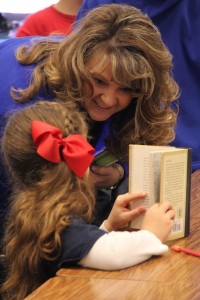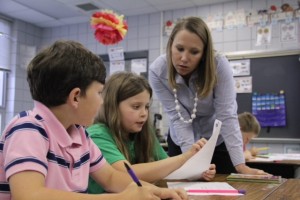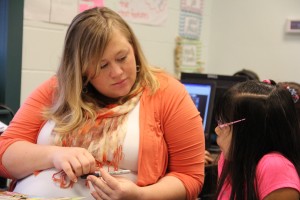What We Learned This Year Watching Schools Prepare For Florida’s New Standards

Jackie Mader / The Hechinger Report
Darlene Paul, principal of West Defuniak Elementary, speaks to a student during a visit to a third-grade classroom. Paul says she has been impressed with the academic success of young students who have been taught only using the new Florida Standards.
For the past year The Hechinger Report and StateImpact Florida have taken you into two schools to hear what preparations for Florida’s new Common Core-based standards sound like. The standards outline what students should know in math and language arts. When classes start this fall every grade in every Florida public school will use them. But are schools ready?
The Hechinger Report’s Jackie Mader and StateImpact Florida’s John O’Connor tell us what they’ve learned.
The teachers at Tampa’s Monroe Middle School are confident that the transition to Florida’s new standards will go well. They’ve got a principal and superintendent enthusiastic about Common Core, and say that they’re on track for the changes.
“A lot of times in education they put things under different names when it’s something you’ve been doing all along, so I think we’re probably doing mostly what we need to do already,” said gym teacher Shane Knipple. Civics teacher Tony Corbett agreed. “It just gives us 10 things to focus on that we’ve already been focusing on.
Although the teachers at Monroe Middle School are optimistic, many teachers and school leaders think the switch to Common Core is the biggest change in education now, and it’s taken a lot of work.

